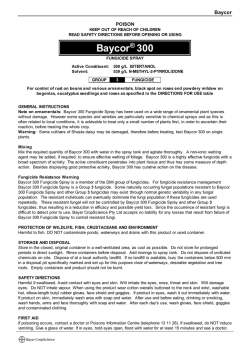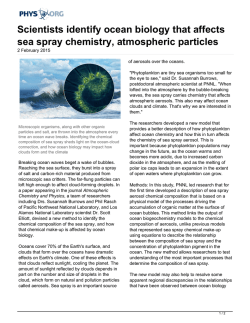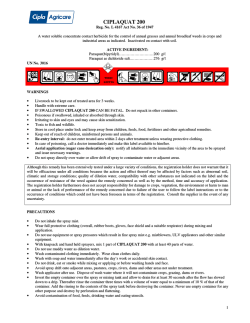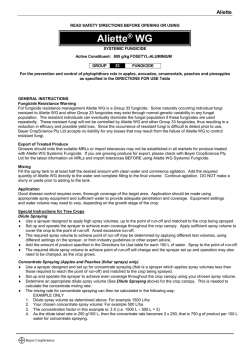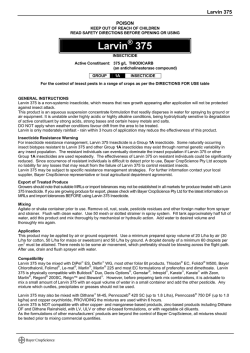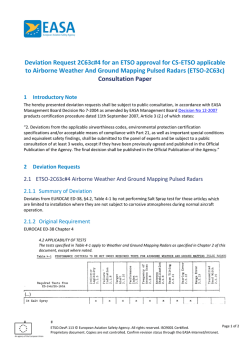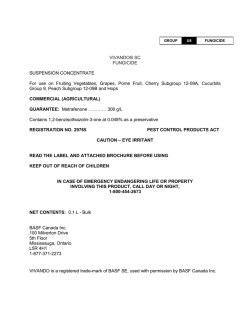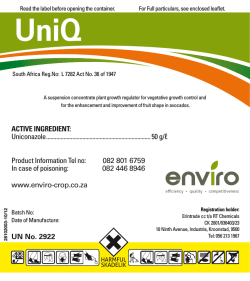
Potato
Potato Seed Treatment Disease Control2 Chemical Application Dosage1 Remarks Fungi3 Azoxystrobin (11) Dynasty, 9.6% Water-based slurry Fludioxonil (12) Maxim 0.5% 0.10-3.75 fl oz/cwt X Dust 8.0 oz/cwt X Maxim 4FS Liquid X Spirato 480FS 40.3% Slurry 0.04-0.08 fl oz/cwt 0.08 fl oz Dust 0.5 lb/cwt X Fludioxonil (12) + mancozeb (M3) Maxim MZ, 0.5%:9.6% Fludioxonil (12) + Thiamethoxam Cruiser Maxx Potato 7.0%:28% Mancozeb (M4) Koverall, 75% Liquid Slurry 0.19-0.27 fl oz/cwt rate depends on seeding rate X X 1.25lb/50 gal water X Manzate Flowable, 37% Slurry 1 qt/50 gal water X Manzate Prostick, 75% Dust 1.25 lbs/50 gal water X PSP 6% Dust 1 lb/cwt X PST Plus Bark 6% Dust 1 lb/cwt X Penncozeb 75% Slurry 1 ¼ lbs/50 gal water X Penncozeb 80 WP, 80% Slurry Roper DF Rainshield, 75% Mancozeb (M4) + Flutolanil (7) Moncoat MZ, 6.0% : 1.5% Penflufen (7) + Prothioconazole (3) Emesto Silver 9.35%:1.68% Slurry Thiophanate methyl (1) ST-Methyl 540 FS, 46.2% Bacteria4 For suppression of black scurf and stem canker and seed-borne black dot, and for protection against silver scurf. Maxim and Maxim MZ are formulated as dusts to be applied to cut or single-drop seed before planting. Maxim products effectively suppress Fusarium dry rot seed decay, stem cankers and tuber black scurf caused by seed-borne Rhizoctonia solani and seed-borne Helminthosporium solani, the causal agent of silver scurf disease. Half rates are recommended for processing (fries). To aid in control of certain insects and Fusarium dry rot and other fungal diseases. For suppression of Fusarium dry rot, Rhizoctonia, seed-borne common scab and silver scurf. Only Mancozeb will reduce the spread of Phytophthora infestans, the cause of late blight, during seedcutting operations. Dip seed pieces into mixture X 1.25 lb/50 gal water Dust X 0.75-1lb/cwt X Diluted Spray Slurry 0.31 fl oz-cwt X Slurry 0.5-0.7 fl oz/cwt X 1 Dosage For suppression of Rhizoctonia and Fusarium dry rot seed decay. MZ added to suppress Fusarium dry rot seed decay. For suppression of Rhizoctonia solani, black scurf, stem and stolon canker caused by seed-borne and soil-borne Rhizoctonia, silver scurf caused by Helminthiosporum solani and seed piece rot caused by Fusarium. For added Fusarium protection apply a MZ product designed for potatoes. For aiding the control of dry rot, black scurf and stem canker, and silver scurf = amount of formulated product to apply. = product labeled for crop and disease; Blank = product not labeled for specific disease. 3Fusarium, Rhizoctonia solani and Helminthosporium solani. These fungi cause dry rot, Rhizoctonia stem canker and silver scurf. 4Includes Erwinia, cause of soft rot decay, and Clavibacter, cause of ring rot. 2X 61 Potato Soil Application Chemical (Fungicide Group) Application Bacillus subtilis Strain QST 713 (44) Serenade Soil 1.74% In-furrow at planting Azoxystrobin (11) Quadris, 22.9% Satori, 22.9% Equation, 22.9% Pyraclostrobin (11) Headline EC, 23.6% Headline SC, 22.3% Cyazofamid (21) Ranman 34.5% Dosage1 2-6 fl qt/A X In-furrow spray 0.4-0.8 fl oz/1,000 ft. of row X In-furrow Fluxapyroxad (7)+ Pyraclostrobin (11) Priaxor 14.33%: 28.58% Penthiopyrad (7) Vertisan, 20.6% Resistance statement 53. For control of black scurf (Rhizoctonia solani) and Silver scurf (Helminthosporium solani). Also controls black dot caused by Colletotrichum coccodes. Apply as in-furrow spray in 5-15 gal of water at planting. Maximum application rate is 0.73 fl oz/1,000 feet of row. X X 0.79-1.18 oz/1,000 ft. row of a 36 in row For additional control of Pink Rot. X Maximum application rate of 1.5lb of azoxystrobin and 0.5 lb of mefenoxam products per acre per season. X In-furrow spray 0.48-0.6 fl oz/1,000 ft. row. X In-furrow X 0.7-1.6 fl oz/1,000 ft row X For suppression of Powdery Scab. Apply infurrow over the seed piece immediately prior to covering over the seed piece with soil using at least 5 to 10 gpa. Use 1.5 pint per acre rate on fields with a history of low levels of powdery scab or with low numbers of spore balls present in the soil. Apply 3 pints per acre rate to fields with a history of moderate to heavy disease pressure or with moderate to high numbers of spore balls present in the soil. 24 c labels for use in Minnesota and North Dakota. In-furrow spray 1.5-3.0 pts/A In-furrow Remarks Apply as directed spray in the seed furrow and to the covering soil at planting for management of Rhizoctonia 0.42 fl. oz/1,000ft row 2.75 fl oz/A in minimum of 20 gallons of finished spray solution Azoxystrobin(11)+ Mefenoxam (4) Quadris Ridomil Gold In-furrow spray 0.82 fl oz/1,000 ft. of row SL Flutolanil (7) Moncut, 70% Pink Rot X In-furrow spray 0.4-0.6 fl oz/1,000 ft. of row (5.8-8.7 fl oz/A with 36" rows) lay by Fluazinam (29) Omega 500F, 40% Control of Pythium Rhizoctonia2 Leak Resistance statement 5 and 63 For 34-inch rows or less, use a maximum of 0.48 fl oz product per 1000 row feet Maximum rate per acre per application is 24 fl oz. 1Dosage = amount of formulated product to apply. = product labeled for crop and disease; Blank = product not labeled for specific disease. 3See fungicide resistance management statement on Pages 7-8. 2X 62 Potato Soil Application (Continued) Chemical (Fungicide Group) Fluopicolide (43) Presidio, 39.5% Mefenoxam (4) Ridomil Gold EC or SL, 48% Dosage1 Application Control of Pythium Rhizoctonia2 Leak Pink Rot 6-8 inch band, 4 fl oz/A in furrow X 6-8 inch band, 0.42 fl oz /100 ft. in furrow or of row impregnated on dry fertilizer X X Ultra Flourish, 25.1% 0.84 fl oz /100 ft. of row X X Platinum Ridomil Gold, 9% 2.2 fl oz /1,000 ft. row X X Phosphites (33) Sodium (mono - and - dibasic) Potassium, and Ammonium Phosphites (33), Several products check label X Remarks Apply in band at planting directly over seed pieces. To avoid resistance and maximize disease control, an effective fungicide must be tank mixed with Presidio fungicide. Resistance statement 43. For postharvest control of pythium leak and pink rot caused by Phytophthora erythroseptica. Platinum Ridomil Gold contains 4.5% thiamethoxam for control of various potato insects. Apply in a band at planting directly over the seed pieces. For Pythium leak control, apply in combination with mefenoxam fungicide. Soil applications have not been shown to be efficacious with this fungicide. Foliar applications are recommended. 1Dosage = amount of formulated product to apply. = product labeled for crop and disease; Blank = product not labeled for specific disease. 3See fungicide resistance management statement on Pages 7-8. 2X Potato Foliar Sprays Disease Control3 Chemical (Fungicide Group) Boscalid (7) Endura, 70% Application1 Dosage2 Remarks4 Late Blight Spray or fungigation 2.5-4.5 oz/a (EB) 5.5-10 oz/A (white mold) 1Spray Early Blight X Resistance statement 65. Recent NDSU Research has indicated that >90% of the A. solani is resistant to boscalid. 10-day PHI. Also controls Sclerotinia white mold and Botrytis. For white mold control, apply prior to infection generally just prior to row closure. For early blight control, apply prior to disease onset. Do not exceed 20 oz/A per season. = ground or aerial; Fungigation = application through sprinkler irrigation system. = amount of formulated product to apply. 3X = product labeled for crop and disease; Blank = product not labeled for specific disease. 4Check the NDSU blight hotline, (888) 482-7286, for information on infection potential of early blight and late blight. Whenever late blight is severe, vine killing is extremely important and should be done at least 2 weeks before harvest to prevent tuber infections. Hilling of soil around the vines should be done just before killing them. 5See fungicide resistance management statement on Pages 7-8. 2Dosage 63 Potato (continued) Foliar Sprays Disease Control3 Chemical (Fungicide Group) Penthiopyrad (7) Vertisan, 20.6% Application1 Spray or fungigation Dosage2 Late Blight 10-24 fl oz/A (early blight) Early Blight X 14-24 fl oz/A (white mold) Resistance statement 65 Recent NDSU research demonstrated that >70% of Alternaria solani isolates are resistant to another FRAC 7 product, Boscalid, and over 50% of those isolates are also resistant to Penthiopyrad. Begin applications prior to disease development. Repeat applications every 7-14 days. For white mold, make initial application at full bloom. Do no exceed 72 fl oz/A per season and make no more than 2 sequential applications. PHI = 7 days 14-24 fl oz/A (black dot) Bacillus subtilis strain QST 713 (44) Serenade ASO Chlorothalonil (M5) Bravo WeatherStik, Equus 720, Echo 720 or Chloronil 720, 54% Remarks4 Spray or fungigation 2-6 qt/A X X Include in a multiple spray program for management of early blight. Spray or fungigation 0.75 pt/ A 1st application. 1.01.5 pt/A subsequent applications X X Bravo Ultrex DG, 82.5% Spray or fungigation 0.7-1.4 lb/A X X Do not apply more than 11.25 lb ai of chlorothalonil per acre per season (23 pt of 40.4%, 16 pt of 54%, 14.5 lb of 82.5%, 13 lb of 90%). Do not apply within 7 days of harvest. A 24 (C ) state label has been granted to Echo 720, Echo ZN to allow up to 16 lb ai per acre per season for late blight control. Bravo Zn, Echo Zn or Terranil Zn, 38.5% Spray or fungigation 1.0-2.13 pt/A X X X X Equus DF, 82.5% Spray or fungigation 0.7 lb/A first application. 0.91.36 lb/A subsequent applications Echo 90 DF, 90% Fluxapyroxad (7) + Pyraclostrobin (11) Priaxor 14.33%:28.58% Spray or fungigation Spray or fungigation 0.63-1.25 lb/A X 4 to 8 fl oz/A X 1Spray X X Do not apply more than 16 lb ai of Bravo Zn, Bravo Weatherstik or Bravo ZN per season (30.5 pt Bravo Zn, 21.5 pt of Bravo Weatherstik or Bravo Weatherstik Zn). Bravo Ultrex has a maximum 10-day interval between applications for potato late blight control. Resistance Statements 5 and 65 Recent NDSU research demonstrated that >90% of Alternaria solani isolates are resistant to another FRAC 7 product, Boscalid, and greater than 50% of those isolates are also resistant to Fluxapyroxad. Also, >90% of A. solani isolates are resistant to pyraclostrobin Also for control of Black dot, Brown Spot and blackpit, and suppression of Botrytis gray mold. For suppression of late blight only Do not apply more than 3 applications or 24 fl oz/A per season. PHI=7 days. = ground or aerial; Fungigation = application through sprinkler irrigation system. = amount of formulated product to apply. 3X = product labeled for crop and disease; Blank = product not labeled for specific disease. 4Check the NDSU blight hotline, (888) 482-7286, for information on infection potential of early blight and late blight. Whenever late blight is severe, vine killing is extremely important and should be done at least 2 weeks before harvest to prevent tuber infections. Hilling of soil around the vines should be done just before killing them. 5See fungicide resistance management statement on Pages 7-8. 2Dosage 64 Potato (continued) Foliar Sprays Chemical (Fungicide Group) Application1 Disease Control3 Late Early Blight Blight Dosage2 Copper (M1) Basicop WP, 53% Spray 3-6 lbs/A X X Champ DP, 57.6% Spray or fungigation 0.66-2.66 lb/A X X Spray or fungigation 1-1 ½ lbs/A X Champ Formula 2 Flowable, 37.5% Spray or fungigation 0.66-2.66 pt/A X Cuprofix Ultra 40 Disperss 71.1% Spray or fungigation .75-3.0 lb/A X X Kocide 2000, 53.8% Spray or fungigation 1.25-6lb/A X X Kocide 3000, 46.1% Spray or fungigation 0.5-1.75 lb X X Kocide 4.5 LF, 37.5% Spray or fungigation 0.66-2.66 pt/A X X MasterCop, 21.46% Spray or fungigation 0.5-1.5 pt/A X X Badge X2, 45.31% Spray or fungigation 0.5-1.75 lbs/A X X Badge SC, 32.17% Spray or fungigation 1-3 lbs/A X X Spray 10 lb/A Spray or fungigation 3 1/3 oz/A X Spray or fungigation 6 oz/A X Cymoxanil (27) Curzate 60 DF, 60% Dimethomorph (40) Forum, 43.5% Do not apply Basicop through irrigation system. Coppers are not effective under high disease pressure. Champ WG, 77% Copper Sulfate (M1) Blue Viking Star Glow Powder or Triangle Brand Copper Sulfate Instant Powder Remarks4 X Control will be improved by tank mixing with other compatible registered fungicides. For application with Diquat desiccant to enhance vine desiccation and suppress late blight. 1Spray Must be tank-mixed with a protectant fungicide. Do not apply within 14 days of harvest. Do not exceed 30 oz/A per season. Do not apply Forum alone; must be tank-mixed with fungicides other than mefenoxam or metalaxyl registered for late blight control. 4-day PHI. = ground or aerial; Fungigation = application through sprinkler irrigation system. = amount of formulated product to apply. 3X = product labeled for crop and disease; Blank = product not labeled for specific disease. 4Check the NDSU blight hotline, (888) 482-7286, for information on infection potential of early blight and late blight. Whenever late blight is severe, vine killing is extremely important and should be done at least 2 weeks before harvest to prevent tuber infections. Hilling of soil around the vines should be done just before killing them. 5See fungicide resistance management statement on Pages 7-8. 2Dosage 65 Potato (continued) Foliar Sprays Disease Control3 Chemical (Fungicide Group) Fluopyram (7) + Pyrimethanil (9) Luna Tranquility 11.3%:33.8% Application1 Dosage2 Remarks4 Late Blight Spray or fungigation Early Blight X 11.2 fl oz/A Fluazinam (29) Omega 500F, 40% Spray or fungigation Iprodione (2) Rovral 4F, 41.6% Nevado 4F, 41.6% Ground spray or fungigation 1-2 pt/A, early blight Mancozeb (M3) Dithane DF Rainshield NT, 75% Spray or fungigation 0.5-2 lb/A X X Dithane F-45, 37% Spray or fungigation 0.8-1.6 qt/A X X Dithane M-45, 80% Spray or fungigation 1-2 lb/A X X Koverall, 75% Spray or fungigation 1-2 lb/A X X Manex II, 37% Spray or fungigation 0.8-1.6 qt/A X X Manzate ProStick, 75% Spray or fungigation 1-2 lb/A X X Manzate Flowable, 37% Spray or fungigation 1-2 lb/A X X Penncozeb, 80% Spray or fungigation 1-2 lb/A X X Penncozeb DF, 75% Spray or fungigation 1-2 lb/A X X Roper DF Rainshield, 75% Spray or fungigation 1-2 lb/A X X 5.5 fl oz/A for late blight 5.5-8 fl oz/A for white mold 1.5-3.0 pints/A infurrow for powdery scab X Begin applications when conditions favor disease development. Repeat applications at 710 days. Do not apply more than 3.5 pts per acre per season. Do not apply within 14 days of harvest. Provides some tuber protection against late blight when used at the end of the season. X 1 Resistance statement 65. None of the currently known SDHI mutations of the pathogen causing early blight (Alternaria solani) that affect boscalid appear to affect fluopyram. Also effective against white mold, botrytis, brown spot, and black dot. . Apply Luna Tranquility mid-season on a 7 to 14 day interval. For resistance management of early blight and improved late blight management mix Luna Tranquility with an EBDC or chlorothalonil. Do not apply more than 2 sequential applications or any Group 7 or 9 containing fungicide before rotating with a fungicide form a different group. PHI=7 days. Resistance statement 25. Rovral Nevado 4F also are labeled for control of white mold. Do not apply within 14 day of harvest. If pH of spray water is above 7.0, buffer it to pH 5.0-7.0. Do not apply within 14 days of harvest. Vine kill should occur 14 days before harvest. Do not apply more than 11.2 lb ai/A per season of total EBDC (mancozeb, maneb or metiram). We recommend that this product be used with an Integrated Pest Management Program. Spray = ground or aerial; Fungigation = application through sprinkler irrigation system. Dosage = amount of formulated product to apply. 3 X = product labeled for crop and disease; Blank = product not labeled for specific disease. 4 Check the NDSU blight hotline, (888) 482-7286, for information on infection potential of early blight and late blight. Whenever late blight is severe, vine killing is extremely important and should be done at least 2 weeks before harvest to prevent tuber infections. Hilling of soil around the vines should be done just before killing them. 5 See fungicide resistance management statement on Pages 7-8. 2 66 Potato (continued) Foliar Sprays Disease Control3 Chemical (Fungicide Group) Mancozeb (M3) + Copper (M1) Mankocide, 15.0%:46.1% Mancozeb (M3) + Zoxamide (22) Gavel, 66.7%:8.3% Mandipropamid (40) + Difenoconazole (3) Revus Top, 21.9%:21.9% Mefenoxam (4) + Chlorothalonil (M5) Ridomil Gold/Bravo WP,4.5%:72% Ridomil Gold/Bravo Liquid Mefenoxam (4) + Copper Hydroxide (M1) Ridomil Gold/Copper WP, 5%:60% Application1 Dosage2 Late Blight Early Blight Spray or fungigation 1.5-5.0 lbs/A X X Spray or fungigation 1.5-2 lb/A X X Spray or fungigation 5.5-7.0 fl oz/A X X 2 lb/A X5 X X5 X Spray or fungigation Spray or fungigation Spray or fungigation 1 container/ 10 acres 2.0 lb/A + 0.8 lb ai/A of maneb, mancoze b, metiram or chlorothal onil 1Spray Remarks4 Do not use within 3 days of harvest. Do not apply within 14 days of harvest. Do not make more than 6 applications or apply more than 12 lbs (8 lbs active mancozeb + 1 lb active zoxamide) per acre per season. Provides some tuber protection against late blight when used at the end of the season. Begin applications before disease development and continue on 7- to 10-day intervals. Also controls black dot and brown spot. Do not make more than 2 applications before switching to a different mode of action. Do not apply within 14 days of harvest or apply more than 28 fl oz/season. Resistance statement 46. Do not apply Ridomil Gold/Bravo, Ridomil Gold/Bravo Liquid or Ridomil Gold/Copper within 14 days of harvest. For late blight control, begin applications when conditions are favorable for late blight, but before infection, and continue at 14-day intervals until threat of disease is over. To minimize the potential for resistance, do not make more than 3 applications. The full rate fo a protectant fungicide should be applied between Ridomil applications, regardless of the Ridomil formulation used. See label for rotation restrictions: waiting period to plant after application of Ridomil (all formulations) is 0 days for dry beans, soybeans, potatoes and sugarbeets; 40 days for wheat, barley, and oats; 9 months for corn; and 12 months for all other crops. A minimum of two applications at 2 lb/A (flowering and 14 days later) for all Ridomil formulations will control A1 late blight tuber rot, Pythium leak and Phytophthora erythroseptica pink rot. For aerial applications a minimum of 5 gal/A spray volume is recommended. = ground or aerial; Fungigation = application through sprinkler irrigation system. = amount of formulated product to apply. 3X = product labeled for crop and disease; Blank = product not labeled for specific disease. 4Check the NDSU blight hotline, (888) 482-7286, for information on infection potential of early blight and late blight. Whenever late blight is severe, vine killing is extremely important and should be done at least 2 weeks before harvest to prevent tuber infections. Hilling of soil around the vines should be done just before killing them. 5Mefenoxam provides average control of new mating types of the late blight fungus; it provides excellent control for mefenoxam-sensitive strains of the A1 mating type. Most late blight strains present since 1998 are resistant to mefenoxam. 6See fungicide resistance management statement on Pages 7-8. 2Dosage 67 Potato (continued) Foliar Sprays Disease Control3 Chemical (Fungicide Group) Application1 Dosage2 Mefenoxam (4) + Mancozeb (M3) Ridomil Gold MZ, 4%:64% Spray or fungigation 2.5 lb/A Metconazole (3) Quash 50% Spray or fungigation 2.5-4.0 fl oz/A Spray or fungigation 1.5-2 lb/A Metiram (M3) Polyram 80 DF, 80% Late Blight Early Blight Remarks4 X5 X Resistance statement 46. Do not apply Ridomil Gold MZ within 14 days of harvest. For late blight control, begin applications when conditions are favorable for late blight, but before infection, and continue at 14-day intervals until threat of disease is over. To minimize the potential for resistance, do not make more than 3 applications. The full rate of a protectant fungicide should be applied between Ridomil applications, regardless of the Ridomil formulation used. See label for rotation restrictions: waiting period to plant after Ridomil application (all formulations) is 0 days for dry beans, soybeans, potatoes and sugar beets; 40 days for wheat, barley and oats; 9 months for corn and sweet corn; and 12 months for all other crops. Two applications (flowering and 14 days later) at 2.5 lb rate will control A1 late blight tuber rot, Pythium leak and Phytophthora erythroseptica pink rot. For aerial applications, minimum of 5 gal/A spray is recommended. X Also effective on black dot, brown spot, and white mold. Use in a tank mix with Chlorothalonil or Mancozeb. Do not apply more than 2 applications per season. PHI=1 day X Potassium Phosphite (33) + Chlorothalonil (M5) Catamaran Spray or fungigation 4.0-5.5 pt/A X Propamocarb (28) Previcur, 66.5% Spray or fungigation 0.7 pt/A low disease risk 0.9 pt/A medium disease risk 1.2 pt/A high disease risk X 1Spray X X Do not apply within 14 days of harvest. Vine kill should occur 14 days before harvest. Do not exceed 14 lbs/A per season. We recommend that this product be used with an Integrated Pest Management Program. See label for further restrictions. Also for pink rot. See label for application instructions. Do not apply more than 17 pts/A/season. Do not apply within 6 weeks of harvest. Do not apply more than 6 pts of Previcur/acre/season. Do not apply within 14 days of harvest. Use in a tank mix with 0.9 lb ai/acre of chlorothalonil (1.2 pt/acre of Bravo Weatherstik or equivalent) or 1 lb ai mancozeb (1.25 lb/acre of Dithane M-45 or equivalent). = ground or aerial; Fungigation = application through sprinkler irrigation system. = amount of formulated product to apply. 3X = product labeled for crop and disease; Blank = product not labeled for specific disease. 4Check the NDSU blight hotline, (888) 482-7286, for information on infection potential of early blight and late blight. Whenever late blight is severe, vine killing is extremely important and should be done at least 2 weeks before harvest to prevent tuber infections. Hilling of soil around the vines should be done just before killing them. 5See fungicide resistance management statements on Pages 7-8. 2Dosage 68 Potato (continued) Foliar Sprays Chemical (Fungicide Group) Pyrimethanil (9) Scala, 54.6% Application1 Dosage2 Spray or fungigation 7 fl oz/A Spray or fungigation check label Spray or fungigation 1-1.5 lbs/A Topsin 4.5 FL, 45% or TMethyl E-AG 4.5F, Cercobin, 41.3% Spray or fungigation 20-30 fl oz/A Thiophanate Methyl 85 WDG, 85% Incognito 85 WDG, 85% Spray or fungigation 0.8-1.2 lb/A Spray or fungigation 20-30 fl oz/A Sodium (mono - and dibasic -), Potassium, and Ammonium Phosphites (33) Several products Thiophanate methyl (1) Topsin M WSB, or TMethyl E-AG 70 WSB, 70% Incognito 4.5F, 46.2% Late Blight Control3 Early Blight Control3 X X Remarks4 Also effective against Botrytis. Use only in tank mix with protectant such as mancozeb and chlorothalonil. Do not apply more than 35 fl oz/A per season. Do not make more than 2 consecutive applications of Scala. PHI= 7 days. Provides better control when alternated with other fungicides. Also provides suppression of storage rot diseases such as pink rot. Resistance statement 15. Topsin M, Topsin 4.5 Fl acre, Incognito 4.5F, Incognito 85 WDG, and Thiophanate methyl WDG are labeled for white mold control in potatoes. 1Spray = ground or aerial; Fungigation = application through sprinkler irrigation system. = amount of formulated product to apply. 3X = product labeled for crop and disease; Blank = product not labeled for specific disease. 4Check the NDSU blight hotline, (888) 482-7286, for information on infection potential of early blight and late blight. Whenever late blight is severe, vine killing is extremely important and should be done at least 2 weeks before harvest to prevent tuber infections. Hilling of soil around the vines should be done just before killing them. 5See fungicide resistance management statements on Pages 7-8. *Designates restricted-use pesticide. 2Dosage 69 Potato (continued) Foliar Sprays Disease Control3 Chemical (Fungicide Group) Application1 Dosage2 Late Blight Early Blight QoIs Azoxystrobin (11) Quadris, 22.9% Satori, 22.9% Equation, 22.9% Spray or fungigation 6.0-15.5 fl oz/A X X Remarks4 Resistance statement 55 For all Early blight: 6.2 fl oz/A on a 7-day interval or 12.4 fl oz/A on a 14-day interval. Late blight: 6.2 fl oz/A on a 7-day interval as a preventive, 12.415.4 fl oz/A on a 5-day interval when late blight is present. Do not make more than 6 applications per acre per year. Do not apply within 14 days of harvest. Also labeled for black dot control. See label for application instructions. Azoxystrobin (11) + Chlorothalonil (M5) Quadris Opti, 4.6% : 46% Azoxystrobin (11) + Difenoconazole (3) Quadris Top 18.2%:11.4% Famoxadone (11) + Cymoxanil (27) Tanos, 25% : 25% Spray 1.6 pt/A X X Spray or fungigation 8-14 oz/A X X Also controls blackdot, brown spot, powdery mildew and Septoria leafspot. Apply on a 7- to 14day interval; do not make more than 2 sequential applications before rotating to an alternate MOA. Quadris top should be used with an adjuvant such as a non-ionic based surfactant or corp oil concentrate or blend. Do not exceed 55.3 oz/A/season. PHI = 14 Use 6 oz/A for early blight and 8 oz/A for late blight. Do not make more than 1 application of Tanos before alternating with a fungicide that has a different mode of action. Maximum of 72 oz/A/season. Spray or fungigation 6-8 oz/A X 1Spray X = ground or aerial; Fungigation = application through sprinkler irrigation system. = amount of formulated product to apply. 3X = product labeled for crop and disease; Blank = product not labeled for specific disease. 4Check the NDSU blight hotline, (888) 482-7286, for information on infection potential of early blight and late blight. Whenever late blight is severe, vine killing is extremely important and should be done at least 2 weeks before harvest to prevent tuber infections. Hilling of soil around the vines should be done just before killing them. 5See fungicide resistance management statements on Pages 7-8. *Designates restricted-use pesticide 2Dosage 70 Potato (continued) Foliar Sprays Disease Control3 Chemical (Fungicide Group) Application1 Dosage2 Late Blight Remarks4,5 Early Blight Qols (continued) Fenamidone (11) Reason, 44.4% Fluoxastrobin (11) Evito, 40.3% Pyraclostrobin (11) Headline EC, 23.6% Spray 5.5-8.2 fl oz/A X X Spray or fungigation 3.8 fl oz/a X X Spray or fungigation 6-9 fl oz/A early Blight Headlline SC, 23.3% Pyraclostrobin (11) + Metiram (M3) Cabrio Plus, 5.0%:55% Trifloxystrobin (11) Gem 500 SC 42.6% Resistance statement 55. A 2 (ee) allows application of Reason at 4 fl oz/A tank mixed with mancozeb, chlorothalonil for control of early and late blight. Reason can be applied early in the season for management of black dot. Tank mix with a different mode of action for resistance management. Applications should be on a 5- to 10-day interval and alternated with a fungicide with a different mode of action. Do not apply more than 24.6 oz/A of Reason per season. PHI = 14 days. Do not apply within 7 days of harvest. Do not make more than 6 applications per season. X X Use 6-9 fl oz/A for early blight and 6-12 fl oz/A for late blight. *Do not apply within 3 days of harvest. Do not make more than 6 applications per season. Also controls black dot. Apply prior to disease onset. 6-12 fl oz/A late Blight Spray or fungigation 2.0-2.9 lbs/A for black dot & early blight; 2.9 lbs/A for late blight X X Spray 2.9-3.8oz/A early blight 3.8 oz/A late blight X X 1Spray PHI=14 days. For early blight, begin application preventively and continue as needed on a 7- to 10-day interval. For late blight, begin applications preventively. Alternate Gem with a protectant fungicide registered for late blight on a 7- to 10day schedule. Do not apply more than 23 oz. GEM 500SC per season. Do not apply within 7 days of harvest. Do not make more than 6 total applications per acre per season. = ground or aerial; Fungigation = application through sprinkler irrigation system. Dosage = amount of formulated product to apply. 3X = product labeled for crop and disease; Blank = product not labeled for specific disease. 4Check the NDSU blight hotline, (888) 482-7286, for information on infection potential of early blight and late blight. Whenever late blight is severe, vine killing is extremely important and should be done at least 2 weeks before harvest to prevent tuber infections. Hilling of soil around the vines should be done just before killing them. 5See fungicide resistance management statements on Pages 7-8. *Designates restricted-use pesticide 2 71 Potato (continued) Foliar Sprays Disease Control3 Chemical (Fungicide Group) Cyazofamid (21) Ranman, 34.5% Triphenyltin Hydroxide (TPTH)* RUP (30) Super Tin 80WP AgPak, 80% or Agri Tin, 80% Application1 Spray or fungigation Spray or fungigation Dosage2 Late Blight 0.42 fl oz/1,000 linear ft. row or 1.4-2.75 fl oz/A as broadcast spray X 2.5-3.75 oz/A X Early Blight Also for pink rot and Pythium leak control. Do not apply more than 27.5 fl oz per season. Alternate sprays of Ranman with a fungicide from a different chemistry class. X RESTRICTED-USE PESTICIDE. Do not apply within 7 days of harvest. Do not exceed 11.25 oz/A TPTH per season. May use 1.87 oz/A TPTH when used in combination with another fungicide. Ground application must be with closed cab. Do not enter treated area within 48 hours of treatment without proper PPE specified on label. Super Tin 4L label says “do not exceed 18 fl oz/a/season.” or Super Tin* 4L, or Agri Tin* 4L, 40% Remarks4,5 Spray or fungigation 4-6 fl oz/A X 1Spray X = ground or aerial; Fungigation = application through sprinkler irrigation system. = amount of formulated product to apply. 3X = product labeled for crop and disease; Blank = product not labeled for specific disease. 4Check the NDSU blight hotline, (888) 482-7286, for information on infection potential of early blight and late blight. Whenever late blight is severe, vine killing is extremely important and should be done at least 2 weeks before harvest to prevent tuber infections. Hilling of soil around the vines should be done just before killing them. 5See fungicide resistance management statements on Pages 7-8. *Designates restricted-use pesticide 2Dosage 72
© Copyright 2025
